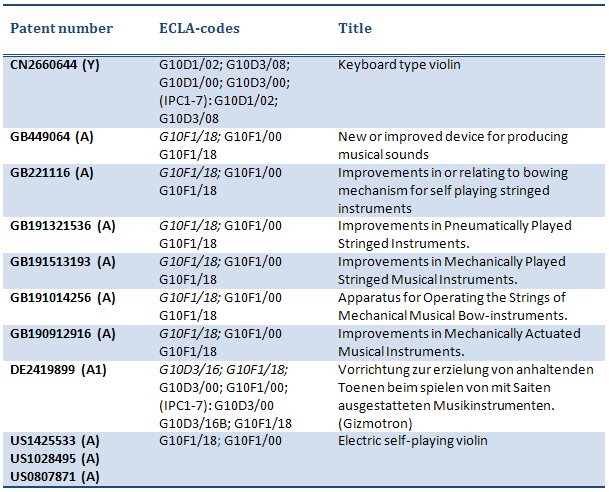Viotar/Patent Research: Difference between revisions
Jump to navigation
Jump to search
No edit summary |
|||
| (8 intermediate revisions by 3 users not shown) | |||
| Line 1: | Line 1: | ||
{|cellpadding="10" | {|cellpadding="10" | ||
|-valign="top" | |-valign="top" | ||
|width="100%" style="border:1px solid #fabd23; background-color:#FEF5DE;"| | |width="100%" style="border:1px solid #fabd23; background-color:#FEF5DE;text-align: justify;"| | ||
{| padding="0" cellspacing="0" style="margin-top:.2em; width:100%; background:none" | {| padding="0" cellspacing="0" style="margin-top:.2em; width:100%; background:none" | ||
| rowspan="32" width="5px" | | | rowspan="32" width="5px" | | ||
| Line 23: | Line 23: | ||
'''Subpages:''' | '''Subpages:''' | ||
</h1><br/> | </h1><br/> | ||
{{:Viotar_Menu}} | |||
|width="2%" style="background-color:#FEF5DE;"| | |width="2%" style="background-color:#FEF5DE;"| | ||
|width="49%" style="border:2px solid #fabd23;"| | |width="49%" style="border:2px solid #fabd23;text-align: justify;"| | ||
<h1 style="font-size:180%; border:none; margin:0; padding:0"> | <h1 style="font-size:180%; border:none; margin:0; padding:0"> | ||
'''Overview:''' | '''Overview:''' | ||
</h1> | </h1><br/> | ||
Because the Viotar is a brand new instrument, something that’s never been seen before, it might be a good idea to patent the design. Because no one of the group had any experience with patents a lot of research on this topic had to be done. On this page the results of this research is briefly summarized.<br/> | Because the Viotar is a brand new instrument, something that’s never been seen before, it might be a good idea to patent the design. Because no one of the group had any experience with patents a lot of research on this topic had to be done. On this page the results of this research is briefly summarized.<br/> | ||
|}<br/> | |}<br/> | ||
{| cellpadding="10" | |||
|-valign="top" | |||
| style="border:2px solid #00FF33; background-color:#CCFF99"| | |||
==Patent Research== | ==Patent Research== | ||
| Line 66: | Line 54: | ||
====Selected patents==== | ====Selected patents==== | ||
From the results of our research, a number of patents has been selected which may have common things with the design of the viotar. This selection is also included in table 1. These patents are chosen because they have at least one aspect that seems to be the same as in our design for the viotar. The patent that has the most similarities with the viotar, is the one on the bottom of table 1 (US1425533 (A)). This patent describes self playing violin from the Mills brothers. Further developments of this design are described in the patents with numbers US1028495 and US0807871. The strings are bowed by little wheels. These wheels are attached to hinges, which push the wheels on the strings using a relais. The idea has strong similarities with the viotar. However, bowing speed and force are not controlled in this design, which is a clear and very important difference. Furthermore, this patent is about a fully automatic violin, where the viotar is played by a musician. | From the results of our research, a number of patents has been selected which may have common things with the design of the viotar. This selection is also included in table 1. These patents are chosen because they have at least one aspect that seems to be the same as in our design for the viotar. The patent that has the most similarities with the viotar, is the one on the bottom of table 1 (US1425533 (A)). This patent describes self playing violin from the Mills brothers. Further developments of this design are described in the patents with numbers US1028495 and US0807871. The strings are bowed by little wheels. These wheels are attached to hinges, which push the wheels on the strings using a relais. The idea has strong similarities with the viotar. However, bowing speed and force are not controlled in this design, which is a clear and very important difference. Furthermore, this patent is about a fully automatic violin, where the viotar is played by a musician. | ||
[[File:octrooien.PNG|frame| Border|center| Tabel 1: Selected patents | [[File:octrooien.PNG|frame| Border|center| Tabel 1: Selected patents ]] | ||
===Viotar | ===Viotar patentable?=== | ||
From the patent research, it is clear to see that the idea of the viotar is not entirely new. There are a few elements from the viotar that can be found in existing patents. For example the idea that all strings are bowed individually by a bowing belt is nog new. Also the electrical drive using keys is found in several patents. However, there is one important thing about the viotar that has not been found in any of them, being the control unit for bowing speed and force. On the base of the results, the idea of controlling bowing speed and force to get a pure tone at all times, could be patentable. The use of bowing belts instead of a regular bow, would not give problems as the found patents are already expired. | |||
Latest revision as of 14:59, 23 March 2011
|
